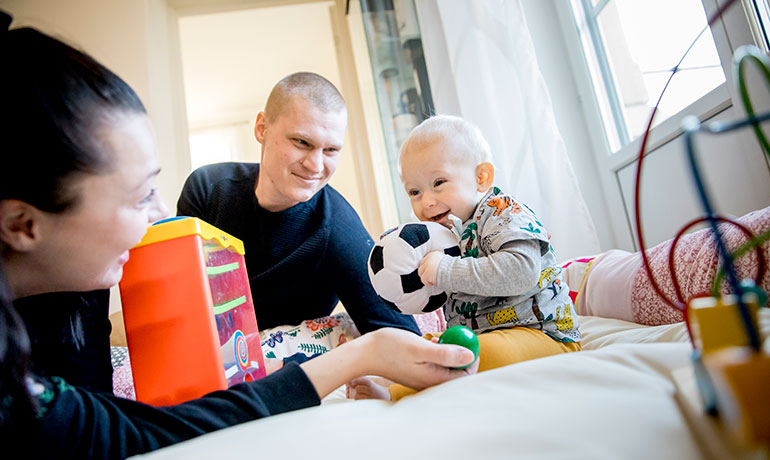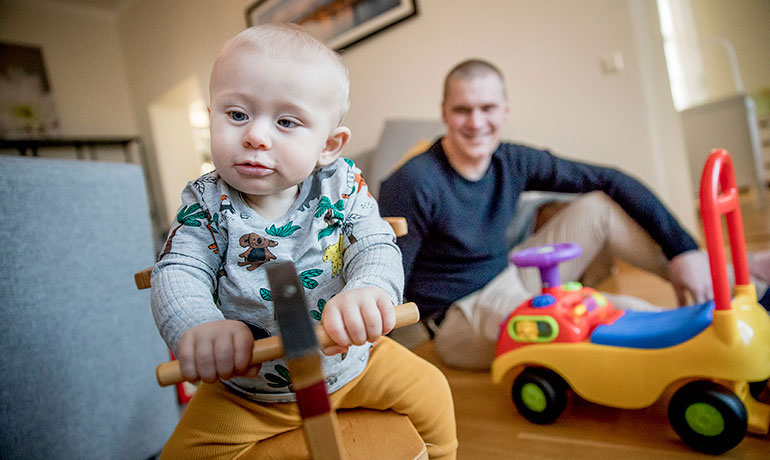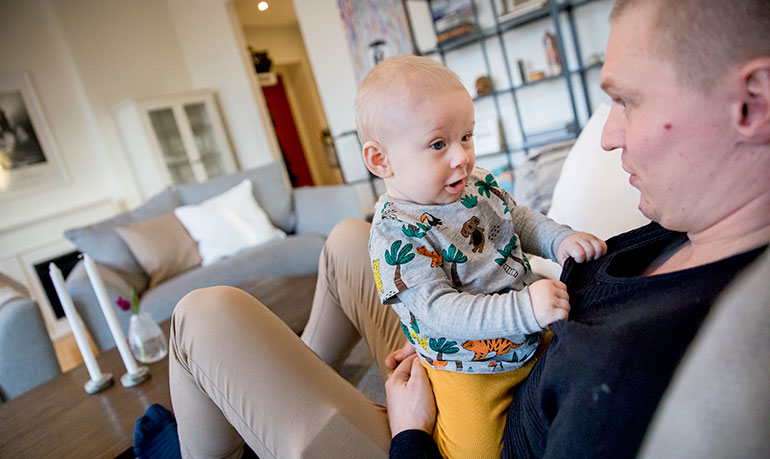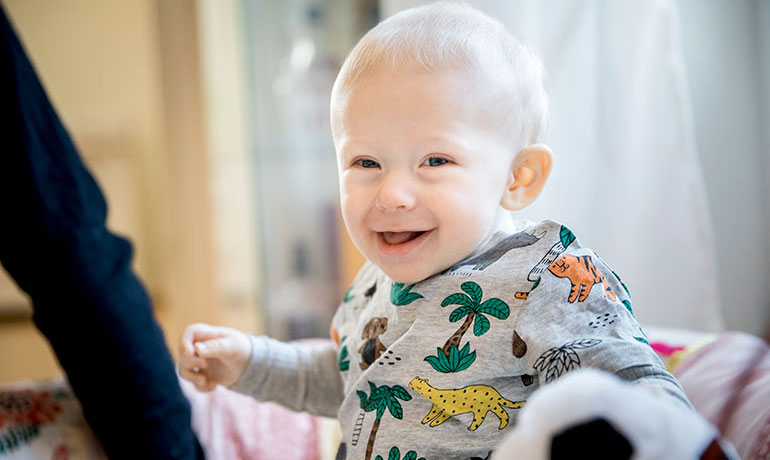
Anders and Frida had not noticed anything off with Liv's eyes.
Photo: Kicki Nilsson
After a normal pregnancy and delivery in May 2019, the new little family had had a lovely first summer together. The mother in the family, Frida, was on parental leave from her job and the father, Anders, had been on holiday from his work..
But at Liv’s three-month check-up in August in her home town, the BVC (the Children’s Health Care Center) nurse was concerned that her eye contact was poor.
“It was a shock to us. We had not considered that there was something off about her sight. We thought it was because babies generally have poor eyesight and we did not have any older siblings to compare with,” says Frida.
A colleague at BVC was called in, who confirmed their fears, and later an on-call doctor. The family was told that Liv would be called for further examination.
“Everyone seemed concerned, but Anders and I didn’t think about a visual impairment, but that Liv would possibly need glasses to correct her eyesight,” says Frida.
Liv’s optic nerves are underdeveloped
Roughly a week later, the family saw a paediatric ophthalmologist.
“The eye doctor noted that both of Liv’s optic nerves are underdeveloped, but it is impossible to say what degree of visual impairment she has. Only Liv can tell us, once she's older,” says Anders.
The ophthalmologist also said there was a risk of damage to nearby areas of the brain, as this has been seen in other children with the same type of visual impairment. But this would be examined later on by a paediatrician at a children’s clinic.
“We had no more than ten minutes with the eye doctor. A very short conversation about something that changed our entire world. We also didn't find out the medical name of the diagnosis or any written information. But we managed to find the name optic nerve hypoplasia by googling at home later on, which, along with the information from the National Board of Health and Welfare made us very worried,” says Anders.

The family thinks the children’s clinic was great.
Photo: Kicki Nilsson
Optic nerve hypoplasia is a congenital malformation meaning that the optic nerves are thin and underdeveloped, which if severe and affecting both eyes can lead to blindness. If the hypoplasia is milder and only affecting one eye there can be just a moderate or slight visual impairment. Today, there is no treatment available for the actual optic nerve. The malformation is unusual and the cause is unclear.
Nearly two weeks later, Liv had an appointment at the children’s clinic at their nearest university hospital. The family had hoped for a faster follow-up and for the eye clinic and the children’s clinic to have better coordination.
“It would have been enough to have a phone call where we could ask our most urgent questions and concerns. It was partly the shock of finding out that our child was visually impaired, and partly that we didn't understand how serious it was considering all the secondary diagnoses we have read about. But once we came to the children’s clinic, they were great and we got more information,” Frida says.
Needed an MRI
In order to find out whether there was any other damage to Liv’s brain, she underwent an MRI (magnetic resonance imaging) of the brain in November under general anaesthesia.
“We were very worried about the results and what it would mean for Liv, for us and for the future. The final result did confirm the diagnosis, but luckily it showed no other damage to the brain than a slightly smaller than normal pituitary gland,” says Frida.
The pituitary gland is one of glands in the body that form hormones and controls other glands. Liv therefore needs to continue with check-ups to monitor her hormone levels, which have been normal so far.
“Now we have a contact nurse at the children’s clinic. It’s a relief, because we can call her if we have any questions,” says Anders.

Livs parents try to have a functioning everyday life and to enjoy Liv’s positive development.
Photo: Kicki Nilsson
The family has declined contact with a health service social worker.
“We have great support from family and friends, and Anders and I discuss any concerns we have. Liv herself is a great source of joy for us, she gives us energy. So at the same time as everything that has happened, we have also tried to have a functioning everyday life and to enjoy Liv’s positive development,” says Frida.
In a few days, the family will visit "Syncentralen", which provides support for people with visual impairments and their families.
“We hope that they can give us tips and advice for how we can help Liv in the best way and make her everyday life easier as her parents,” says Anders.
“Liv is a really happy little girl who enjoys physical activity and she really wants to try walking. She likes sounds and music and when we sing to her, she's doing great. But then we have questions about how we can help her to start crawling and grabbing objects that she cannot see,” says Frida.

Anders and Frida quickly decided to start a fundraiser for research.
Photo: Kicki Nilsson
In conjunction with Liv’s diagnosis, Anders and Frida were planning her christening.
“We quickly decided to have a fundraiser during the christening for research on optic nerve hypoplasia. It was the best gift Liv could have for her christening. Hopefully, the researchers can find the cause of this impairment and how her eyesight can be improved,” says Anders.
He and Frida contacted St. Erik Eye Hospital in Stockholm for advice and help in how to proceed with starting a fundraiser.
Liv also had an appointment at St. Erik’s with the pediatric ophthalmologist, Assistant Professor Kristina Teär Fahnehjelm, who runs optic nerve hypoplasia research projects at St. Erik Eye Hospital and Karolinska Institutet.
“She has a long experience and has seen many children like Liv. We got answers to a lot of questions, which was a relief. And it was great to meet her since the fundraiser concerns her research,” says Anders.
During and after the christening, nearly SEK 20,000 has been collected for research.
“Research is the best chance for Liv and other visually impaired children to have a good life, both in terms of the diagnosis and of everyday life,” says Frida.
Text: Helena Mayer
*The names of the interviewed persons in this article have been changed. This article was first published in Swedish in February 2020.